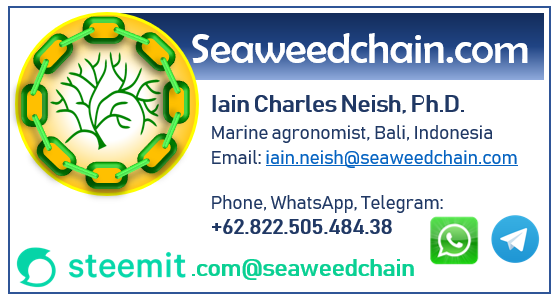Innovation can invigorate bogged-down tropical seaweed value chains
Blockchain technologies like Steemit can help to get farm production out of a rut
In 1965 when I first got involved with seaweed science the industry was dominated by small, innovative companies. Those companies laid a foundation for respectable growth but by the late 1970s they had been absorbed by large firms that stifled innovation, so they could focus on milking profits from cash-cow product lines. During subsequent decades 'copycat' technology fueled proliferation of dozens of processing operations but total industry growth bogged down because innovative products were not being developed to supply significant new markets. Innovative, emerging technologies are now driving growth again and I am hoping that use of the Steemit platform can accelerate progress.
Tropical seaweed farming had strong growth for 30 years … then got bogged down
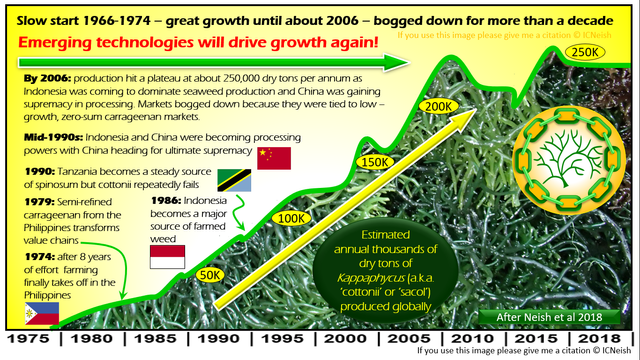
The image above summarizes events that have shaped my life. When I first came to Indonesia in search of seaweed in June 1974 tropical seaweed farming was still a dream. Trial and error had produced plenty of trials, a multitude of errors and deep skepticism among nay-sayers. Suddenly, in 1974, success was finally achieved by the teams of my old friends Vic Alvarez and Max Doty in the southernmost reaches of the Philippines and an industry was born! That event sent me on the way to a life in the tropics. Since then I have spent 40 years in aquaculture development in the Philippines, Malaysia and Indonesia and I am now settled in Bali for ‘the duration’. My focus is on how we can get seaweed aquaculture out of a rut and back on the road to innovation and growth.
Crazy prices have plagued tropical seaweed farming for the past decade
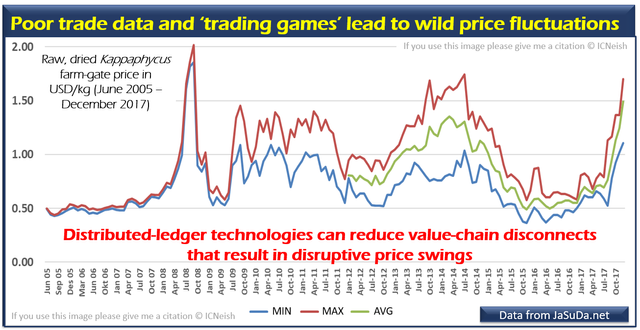
From early days in 1974 until 2008 seaweed prices tracked well with production costs and there was a reasonable balance between supply and demand. In early 2008 all that changed as prices spiked about five-fold for the types of tropical seaweeds that comprised the highest proportion of existing markets. It was ironic that by the time the price spike happened, supply and demand for those seaweeds was substantially balanced. Almost all farmed tropical seaweed was consumed as raw material for making the hydrocolloids known as carrageenan and agar. Those were (and remain as) slow-growing markets with steady demand throughout the year. Poor trade data and trading games contributed to value-chain problems and apparently lessons were not well learned. At the time of writing we are in the midst of the third price spike in a decade. I earnestly hope that distributed ledger technologies will be a factor in providing solutions for this sort of sloppy value chain management.
Alpha players dominate … like whales in cryptocurrencies
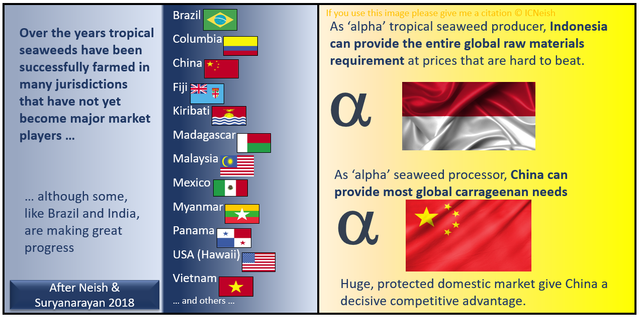
When I started in the game in 1965 three innovative, medium-sized companies dominated the business: one each in the USA, France and Denmark. During the late 1970s those companies were absorbed by large multinational companies even as the advent of semi-refined carrageenan precipitated a swarm of ‘me-too’ processors around the world. During the past decade the situation has settled to a point where a few companies once again dominate the tropical seaweed and carrageenan businesses, and these are in the Philippines, Indonesia and China. At the time of writing Indonesia was the ‘alpha’ seaweed producer; China dominated processing; and the Philippines were losing ground in the zero-sum game that the business became.
Stifled innovation bogs down seaweed farm expansion
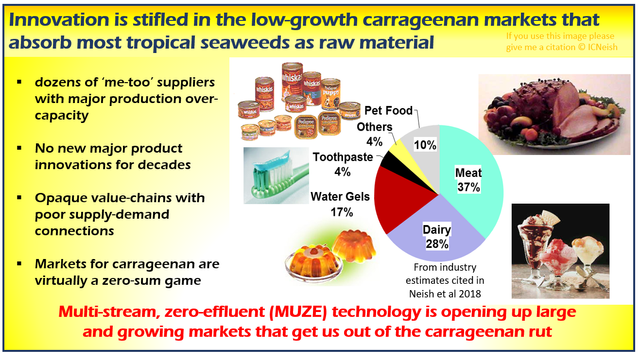
As long ago as 1975 my boss in the carrageenan business was berating our development people because the only major application for carrageenan was “puddings”. Unfortunately, there was little deviation from that scenario in the four decades that followed. Availability of farmed weed made semi-refined products possible and brought down carrageenan prices, but the range of major markets remained pretty much as shown in the figure above. As new processors entered markets they essentially copied the processes and product lines of established processors. This led to the present situation where there is large production over-capacity selling essentially undifferentiated products into markets that are virtually zero-sum games.
Innovative new technologies offer hope for the future
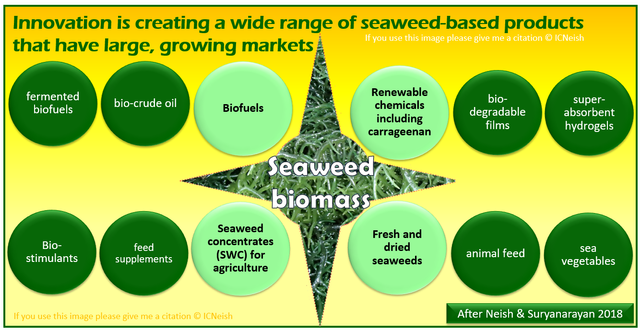
Tropical seaweed farming has become an important source of livelihood for people in thousands of coastal villages both in the Coral Triangle region and elsewhere (see references listed below). Several organizations (both private and public) are keen to see seaweed aquaculture resume development at the pace shown from 1974-2004. This can become possible if the industry moves beyond dependence on low-growth carrageenan and agar (hydrocolloid) markets and develops products with markets that have huge growth potential. Several of the most active areas of product development are listed on the image above. One of the most actively growing markets is for agricultural biostimulants and supplements markets and as such markets gain major traction, the demand for farmed tropical seaweeds will once again be on the rise.
So full Steem ahead …
Cheers, Iain
References:
Neish IC, Sepulveda M, Hurtado AQ & Critchley AT. 2018. Reflections on the commercial development of eucheumatoid seaweed farming, Chapter 1 in Tropical Seaweed Farming Trends, Problems and Opportunities: Focus on Kappaphycus and Eucheuma of Commerce, Hurtado AQ, Critchley AT & Neish IC [Eds], ISBN 978-3-319-63498-2, Springer.
Neish IC & Suryanarayan S. 2018. Development of eucheumatoid seaweed value-chains through carrageenan and beyond. Chapter 12 in Tropical Seaweed Farming Trends, Problems and Opportunities: Focus on Kappaphycus and Eucheuma of Commerce, Hurtado AQ, Critchley AT & Neish IC [Eds], ISBN 978-3-319-63498-2, Springer.
